Instruction
Understanding the “NEW” ball flight laws
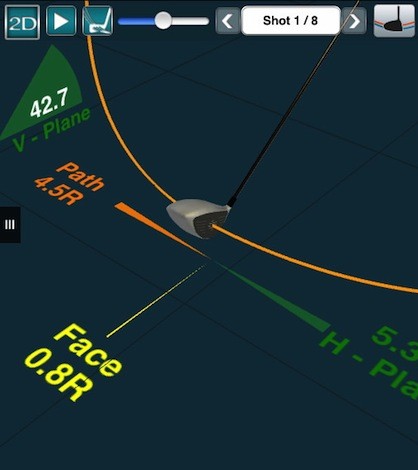
Over the last several years, golf instruction has gone through a unique transformation. The advent of 3D motion analysis, video, and ball/club flight launch monitors have proven to golf instructors that some of the “fundamentals” we were taught by our mentors were incorrect.
With the advent of Trackman and Flightscope, advanced Doppler radar launch monitors that cost upward of $10,000, we are now able to understand what actually happens during the impact interval. This has made golf instruction much simpler as a result.
Students are now learning improved fundamental motions in their own way, while instructors are not so much focused on the complex mechanics of the swing itself. For the facilities that have a Doppler radar launch monitors, such as Promontory, our students are learning under the guise of the “in my own way,” not “ in this way” type of golf instruction.
Trackman and Flightscope provide video-based instruction coupled with the data of club and ball interaction, thus correlating exactly what is going on during the swing. Think of this new technology as providing your instructor with a MRI of your current fundamentals so you both can focus on facts, not opinions.
One of the most important things Doppler launch monitors have given us are the “new” ball flight laws. In the past, golfers were taught that the ball begins in the direction of a club’s path, and the curvature of the ball was due to the face angle at impact. Now, we know that this line of thinking is 100 percent INCORRECT.
In fact, the face angle at impact determines 75 percent or more of the ball’s starting direction, and at slower ball speeds it creeps up to almost 100 percent. This has made curving the ball much easier to understand for my students, and below are examples of this fact all backed up by the data that the my Trackman system shows for each shot.
Example 1: Hitting a Fade
In Example 1, I am hitting the ball left to right, or fading the ball for a right-handed player.
- The solid white line represents my target-line (directly at the flag in the distance).
- The blue line shows the path of the club (negative numbers are out to in).
- The red line determines the direction that my club face was pointing during impact (negative numbers mean a closed face).
You can see by the purple line that this ball began slightly left of my target (3.5 degrees left of my target-line) and faded 34.9 feet to the right of my intended target. This proves that when the path is left of the face angle (provide a centered hit on the club face), you will hit the ball left to right. Thus, if you want to move the ball left to right (for the right-handed player), you MUST have your face open to the club’s path.
NOTE: I said that the club face must be pointing to the right of the club’s path in order to hit a fade, not open to the target line.
My path was 6.6 degrees from out to in (Example 1), my face was 2.6-degrees closed and the ball moved from left to right. Yes, it moved left to right WITH A CLOSED FACE! If my club face had been open 2.6 degrees, then the ball would have curved exaggeratedly to the right. But in this case, there was only a 4 degree path to face differential — the lower that number the less the curvature. That’s why the ball only faded a small amount to the right.
Example 2: Hitting a Draw
In Example 2, I am hitting the ball right to left, or drawing the ball for a right-handed player.
- The solid white line represents my target-line (directly at the flag in the distance).
- The blue line shows the path of the club (positive numbers denote from inside to the outside).
- The red line determines the direction that my club face was pointing during impact (negative numbers mean a closed face).
You can see by the purple line that this ball began down the target line (launch direction is 0), while my face was 1-degree closed. These conditions started the ball at my target, and moved it right to left 55.4 feet.
As you can see in Example 2, when the path is right of the face angle at impact, you will hit the ball right to left (provide a centered hit). The ball flight began very close to the face angle as described above. Thus, if you want to move the ball right to left (for the right-handed player) you MUST have your face closed to the club’s path.
NOTE: I said closed to the relative path, NOT closed to the target line. That brings me to my next point about the shot in Example 2.
You can see that my face-to-path ratio was -6.4 degrees, which means that my club face was 6.4 degrees closed relative to my path’s direction. This is why my ball started at the target and then moved left of it instead of starting right of my target and drawing back to the target.
There is a huge misconception that you must have a closed face to draw the golf ball, when in fact all you need to do is have your club face pointed left of your path. So in Example 2, if my face was more open at impact (let’s so 1 to 3 degrees), then you would have seen the ball start to the right and curve to the target — not to the left of the target as mine did in this example.
The golf swings thoughts above might seem complex due to the numbers involved, but the bottom line for you at home is to do the following:
To Hit a Fade
In order to move the ball left to right, you will need a path that is more left than the face is pointing. So if you keep the club face pointing right of the path it will curve from left to right
To Hit a Draw
Understand that in order to move the ball right to left, you must have a path that is more “in to out” than where your club face points at impact. Another way to think of it is to have the face pointing left of your club’s path — this will allow the ball to move right to left
Read More Tom Stickney II : What Flightscope and Trackman can tell you (and me)
- LIKE66
- LEGIT8
- WOW7
- LOL2
- IDHT2
- FLOP2
- OB1
- SHANK8
Instruction
The Wedge Guy: The easiest-to-learn golf basic

My golf learning began with this simple fact – if you don’t have a fundamentally sound hold on the golf club, it is practically impossible for your body to execute a fundamentally sound golf swing. I’m still a big believer that the golf swing is much easier to execute if you begin with the proper hold on the club.
As you might imagine, I come into contact with hundreds of golfers of all skill levels. And it is very rare to see a good player with a bad hold on the golf club. There are some exceptions, for sure, but they are very few and very far between, and they typically have beat so many balls with their poor grip that they’ve found a way to work around it.
The reality of biophysics is that the body moves only in certain ways – and the particulars of the way you hold the golf club can totally prevent a sound swing motion that allows the club to release properly through the impact zone. The wonderful thing is that anyone can learn how to put a fundamentally sound hold on the golf club, and you can practice it anywhere your hands are not otherwise engaged, like watching TV or just sitting and relaxing.
Whether you prefer an overlap, interlock or full-finger (not baseball!) grip on the club, the same fundamentals apply. Here are the major grip faults I see most often, in the order of the frequency:
Mis-aligned hands
By this I mean that the palms of the two hands are not parallel to each other. Too many golfers have a weak left hand and strong right, or vice versa. The easiest way to learn how to hold the club with your palms aligned properly is to grip a plain wooden ruler or yardstick. It forces the hands to align properly and shows you how that feels. If you grip and re-grip a yardstick several times, then grip a club, you’ll see that the learning curve is almost immediate.
The position of the grip in the upper/left hand
I also observe many golfers who have the butt of the grip too far into the heel pad of the upper hand (the left hand for right-handed players). It’s amazing how much easier it is to release the club through the ball if even 1/4-1/2″ of the butt is beyond the left heel pad. Try this yourself to see what I mean. Swing the club freely with just your left hand and notice the difference in its release from when you hold it at the end of the grip, versus gripping down even a half inch.
To help you really understand how this works, go to the range and hit shots with your five-iron gripped down a full inch to make the club the same length as your seven-iron. You will probably see an amazing shot shape difference, and likely not see as much distance loss as you would expect.
Too much lower (right) hand on the club
It seems like almost all golfers of 8-10 handicap or higher have the club too far into the palm of the lower hand, because that feels “good” if you are trying to control the path of the clubhead to the ball. But the golf swing is not an effort to hit at the ball – it is a swing of the club. The proper hold on the club has the grip underneath the pad at the base of the fingers. This will likely feel “weak” to you — like you cannot control the club like that. EXACTLY. You should not be trying to control the club with your lower/master hand.
Gripping too tightly
Nearly all golfers hold the club too tightly, which tenses up the forearms and prevents a proper release of the club through impact. In order for the club to move back and through properly, you must feel that the club is controlled by the last three fingers of the upper hand, and the middle two fingers of the lower hand. If you engage your thumbs and forefingers in “holding” the club, the result will almost always be a grip that is too tight. Try this for yourself. Hold the club in your upper hand only, and squeeze firmly with just the last three fingers, with the forefinger and thumb off the club entirely. You have good control, but your forearms are not tense. Then begin to squeeze down with your thumb and forefinger and observe the tensing of the entire forearm. This is the way we are made, so the key to preventing tenseness in the arms is to hold the club very lightly with the “pinchers” — the thumbs and forefingers.
So, those are what I believe are the four fundamentals of a good grip. Anyone can learn them in their home or office very quickly. There is no easier way to improve your ball striking consistency and add distance than giving more attention to the way you hold the golf club.
More from the Wedge Guy
- The Wedge Guy: Golf mastery begins with your wedge game
- The Wedge Guy: Why golf is 20 times harder than brain surgery
- The Wedge Guy: Musings on the golf ball rollback
- LIKE83
- LEGIT13
- WOW5
- LOL1
- IDHT0
- FLOP4
- OB1
- SHANK8
Instruction
Clement: Stop ripping off your swing with this drill!

Not the dreaded headcover under the armpit drill! As if your body is defective and can’t function by itself! Have you seen how incredible the human machine is with all the incredible feats of agility all kinds of athletes are accomplishing? You think your body is so defective (the good Lord is laughing his head off at you) that it needs a headcover tucked under the armpit so you can swing like T-Rex?
- LIKE0
- LEGIT2
- WOW2
- LOL0
- IDHT0
- FLOP0
- OB0
- SHANK2
Instruction
How a towel can fix your golf swing
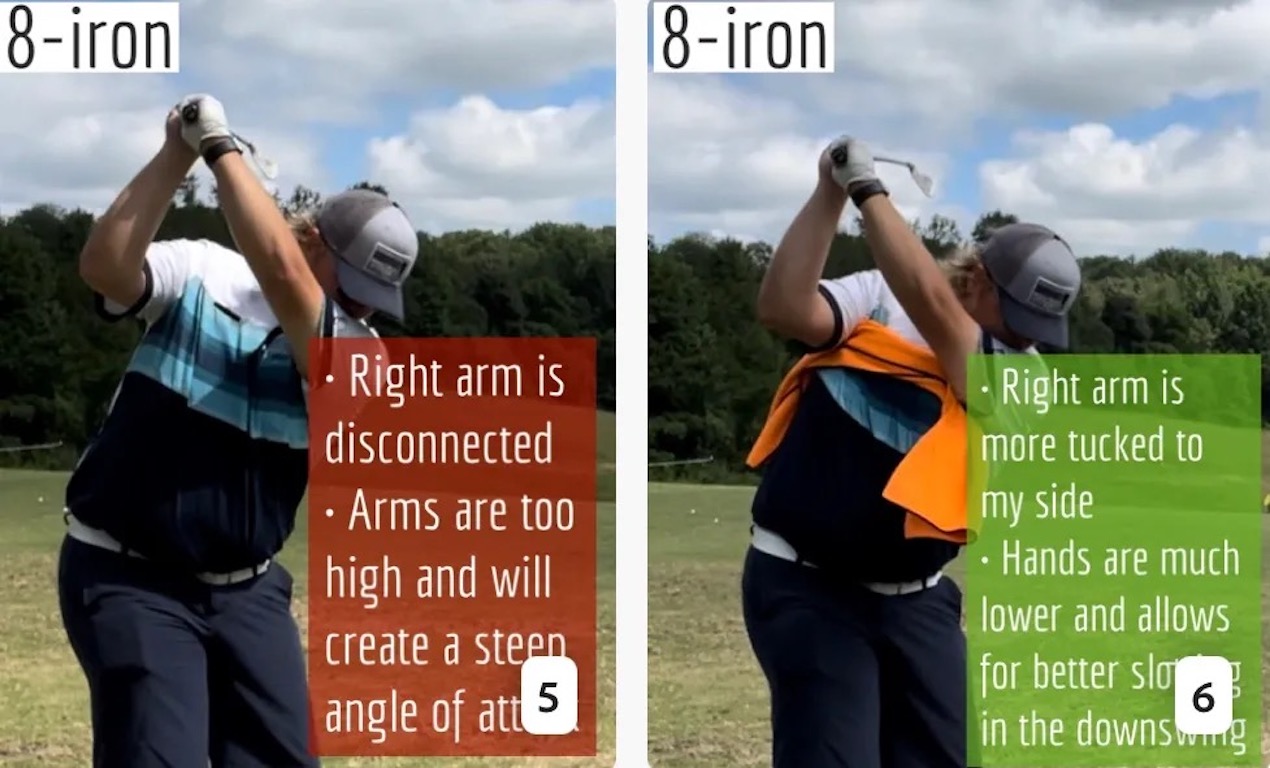
This is a classic drill that has been used for decades. However, the world of marketed training aids has grown so much during that time that this simple practice has been virtually forgotten. Because why teach people how to play golf using everyday items when you can create and sell a product that reinforces the same thing? Nevertheless, I am here to give you helpful advice without running to the nearest Edwin Watts or adding something to your Amazon cart.
For the “scoring clubs,” having a solid connection between the arms and body during the swing, especially through impact, is paramount to creating long-lasting consistency. And keeping that connection throughout the swing helps rotate the shoulders more to generate more power to help you hit it farther. So, how does this drill work, and what will your game benefit from it? Well, let’s get into it.
Setup
You can use this for basic chip shots up to complete swings. I use this with every club in my bag, up to a 9 or 8-iron. It’s natural to create incrementally more separation between the arms and body as you progress up the set. So doing this with a high iron or a wood is not recommended.
While you set up to hit a ball, simply tuck the towel underneath both armpits. The length of the towel will determine how tight it will be across your chest but don’t make it so loose that it gets in the way of your vision. After both sides are tucked, make some focused swings, keeping both arms firmly connected to the body during the backswing and follow through. (Note: It’s normal to lose connection on your lead arm during your finishing pose.) When you’re ready, put a ball in the way of those swings and get to work.
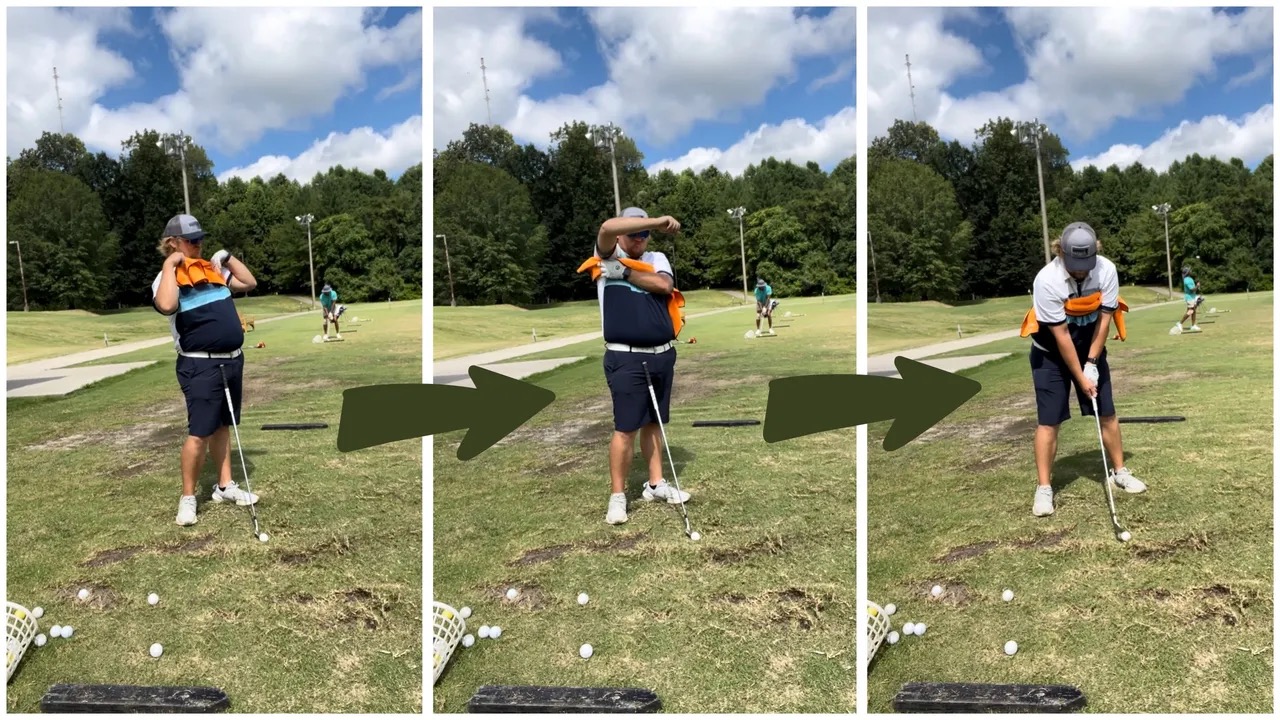
Get a Better Shoulder Turn
Many of us struggle to have proper shoulder rotation in our golf swing, especially during long layoffs. Making a swing that is all arms and no shoulders is a surefire way to have less control with wedges and less distance with full swings. Notice how I can get in a similar-looking position in both 60° wedge photos. However, one is weak and uncontrollable, while the other is strong and connected. One allows me to use my larger muscles to create my swing, and one doesn’t. The follow-through is another critical point where having a good connection, as well as solid shoulder rotation, is a must. This drill is great for those who tend to have a “chicken wing” form in their lead arm, which happens when it becomes separated from the body through impact.
In full swings, getting your shoulders to rotate in your golf swing is a great way to reinforce proper weight distribution. If your swing is all arms, it’s much harder to get your weight to naturally shift to the inside part of your trail foot in the backswing. Sure, you could make the mistake of “sliding” to get weight on your back foot, but that doesn’t fix the issue. You must turn into your trial leg to generate power. Additionally, look at the difference in separation between my hands and my head in the 8-iron examples. The green picture has more separation and has my hands lower. This will help me lessen my angle of attack and make it easier to hit the inside part of the golf ball, rather than the over-the-top move that the other picture produces.
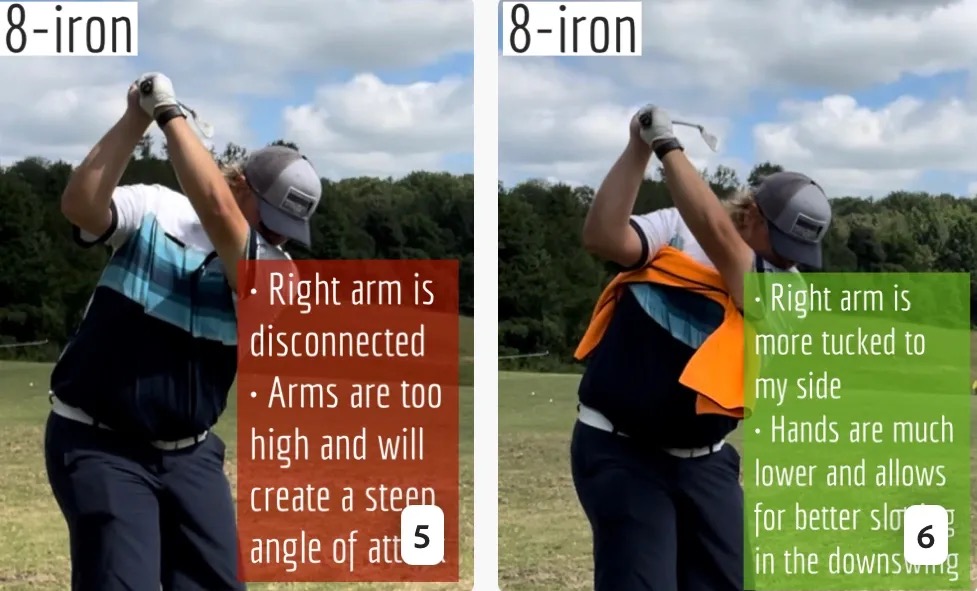
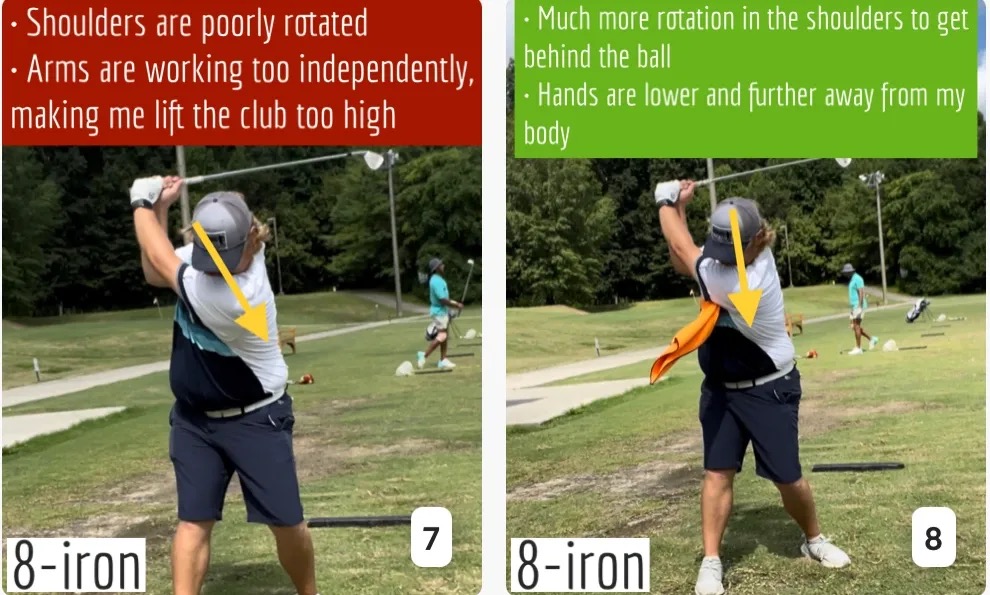
Stay Better Connected in the Backswing
When you don’t keep everything in your upper body working as one, getting to a good spot at the top of your swing is very hard to do. It would take impeccable timing along with great hand-eye coordination to hit quality shots with any sort of regularity if the arms are working separately from the body.
Notice in the red pictures of both my 60-degree wedge and 8-iron how high my hands are and the fact you can clearly see my shoulder through the gap in my arms. That has happened because the right arm, just above my elbow, has become totally disconnected from my body. That separation causes me to lift my hands as well as lose some of the extension in my left arm. This has been corrected in the green pictures by using this drill to reinforce that connection. It will also make you focus on keeping the lead arm close to your body as well. Because the moment either one loses that relationship, the towel falls.
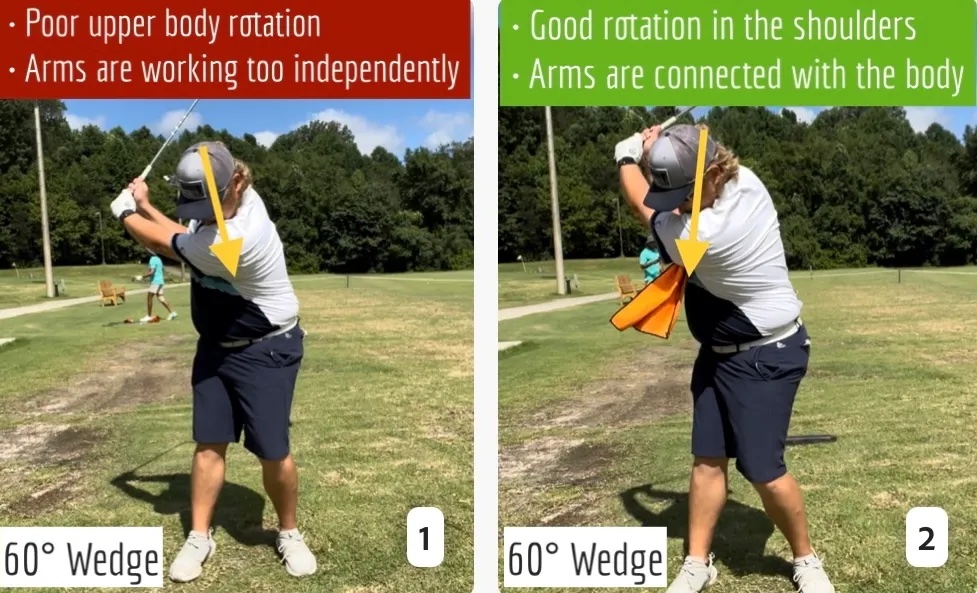
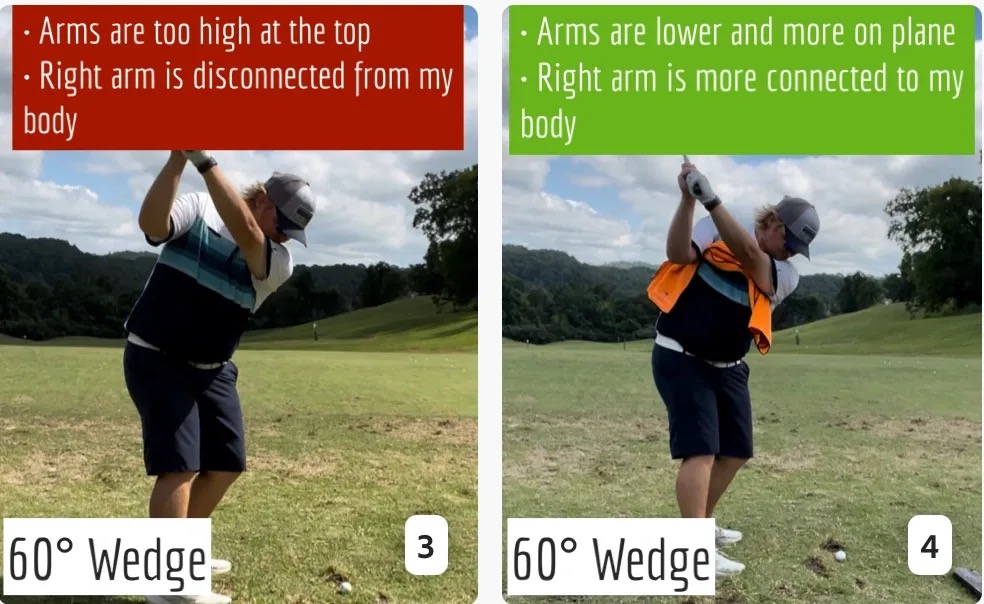
Conclusion
I have been diligent this year in finding a few drills that target some of the issues that plague my golf game; either by simply forgetting fundamental things or by coming to terms with the faults that have bitten me my whole career. I have found that having a few drills to fall back on to reinforce certain feelings helps me find my game a little easier, and the “towel drill” is most definitely one of them.
- LIKE12
- LEGIT2
- WOW2
- LOL0
- IDHT0
- FLOP2
- OB0
- SHANK8
-
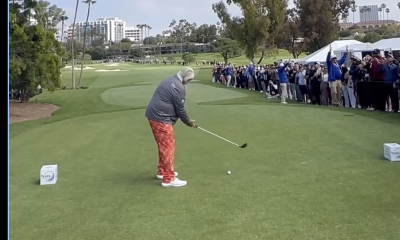
 19th Hole2 weeks ago
19th Hole2 weeks agoJohn Daly stuns fans into silence with brutal opening tee shot on PGA Tour Champions
-
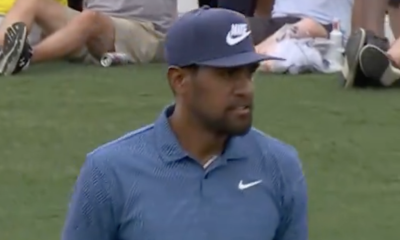
 19th Hole6 days ago
19th Hole6 days agoThings got heated at the Houston Open between Tony Finau and Alejandro Tosti. Here’s why
-

 19th Hole3 days ago
19th Hole3 days agoReport: Tiger Woods has ‘eliminated sex’ in preparation for the 2024 Masters
-
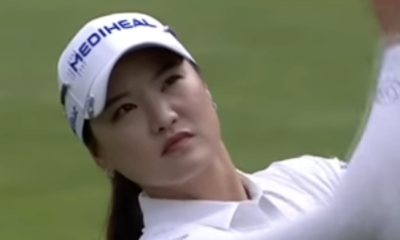
 19th Hole2 weeks ago
19th Hole2 weeks ago2-time major champ announces shock retirement from the sport at age of 33
-

 19th Hole3 weeks ago
19th Hole3 weeks agoEdoardo Molinari reveals the latest PGA Tour golfer to turn down ‘good offer’ from LIV Golf
-
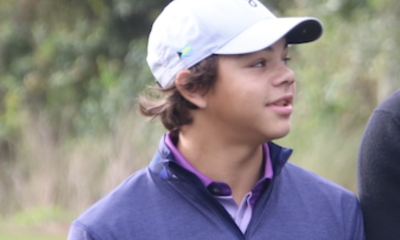
 19th Hole2 weeks ago
19th Hole2 weeks agoCharlie Woods finds it tough going on American Junior Golf Association debut
-
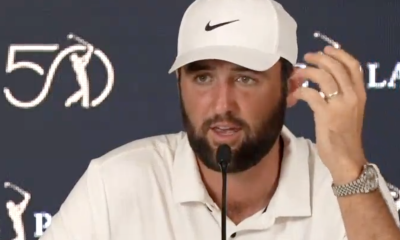
 19th Hole3 weeks ago
19th Hole3 weeks agoScottie Scheffler had an interesting response when asked how he ‘quiets the noise’ following Players victory
-
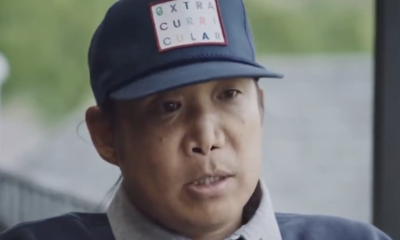
 19th Hole5 days ago
19th Hole5 days agoAddiction, spinal fusion, and scam artists – Everything Anthony Kim revealed in candid interview with David Feherty

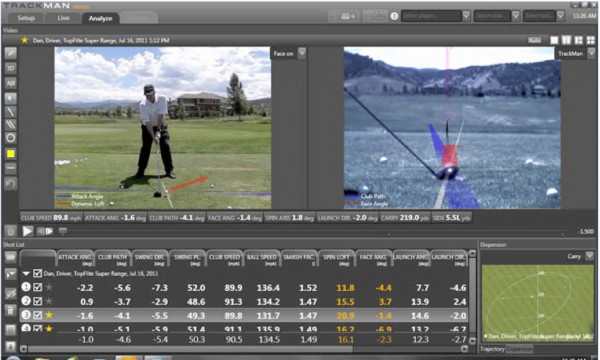
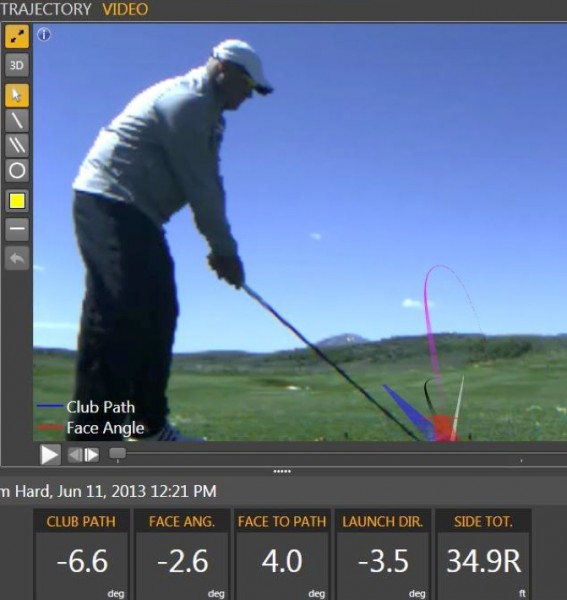
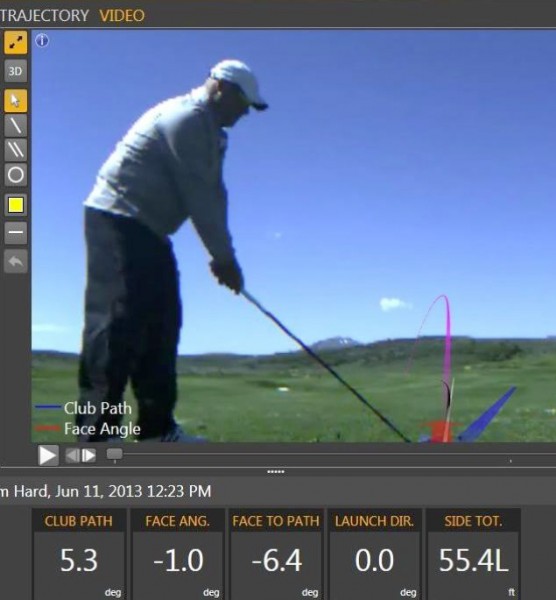










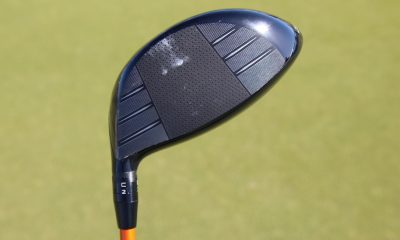

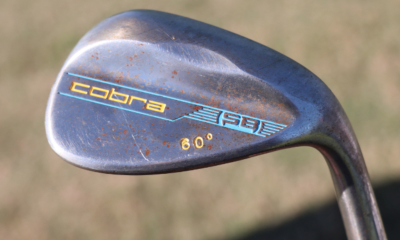

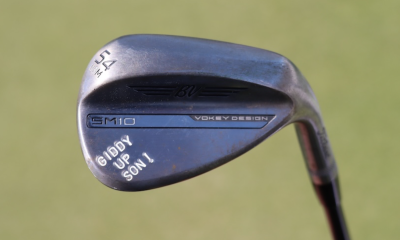

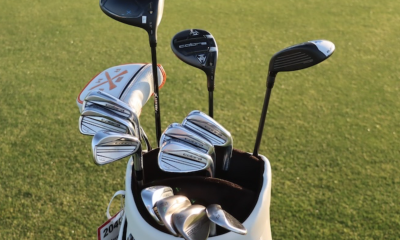

Alec Ordway
Dec 24, 2017 at 9:15 am
This info is as John Jacobs describe for years and years. You’re just proving him right. Swing left go left, swing right go right, swing square go square. Then face angle RELATIVE TO PATH determines ball flight. And all this info has same purpose, control the ball and learn fundamentals to do so. Geesh, same old same old, but now we have new tech to see what our body did as we swung.
Pingback: The Top 10 Myths In Golf | The DIY Golfer
Ian
Aug 3, 2015 at 1:43 pm
“My path was 6.6 degrees from out to in (Example 1), my face was 2.6-degrees closed and the ball moved from left to right. Yes, it moved left to right WITH A CLOSED FACE!” – Closed relative to the target line or closed relative to the swing path? – I know this article is old, but really hope you reply.
Kelly
Aug 11, 2015 at 8:31 am
I’m just another poster, but I am sure he means closed relative to the target line. The face is 4 degrees open to the swing path, but 2.6 degrees closed to the target line.
Chris Howell
May 5, 2015 at 2:49 pm
Way too much confusion on target line and path. I was taught over 20 years ago that club face has to be closed relative to path for the ball to move right to left (right handed golfer) the clubface must be open relative to path for the ball to move right to left (right handed player). This really isn’t new information just that new technology makes it easier to see. As long as your club face is square to your path you will hit the ball straight, but it could be straight left or straight right.
corey
Mar 7, 2014 at 5:39 pm
so much confusion comes from people not having the same definition of a draw and fade. some say a draw or fade starts on the target line and then (for a rh player) will draw to the right of the line or fade to the left of it. others say the ball should start right of the target line and draw back to the line or start left of the target line and fade back onto it. the second example i think should be considered a pull fade or push draw, this is what sean foley teaches. a lot of it comes down to what you are more comfortable using as your target line.
Adrian
Feb 28, 2014 at 2:36 am
I am glad that articles like this continue to be written as there are still a great deal of people who still either have not been exposed to the correct information or have not quite grasped it fully yet. It is so important for this information to be understood.
Jakub Budaj
Feb 22, 2014 at 9:00 am
Clubface starts the ball, path curves the ball.
Michael
Oct 19, 2013 at 11:14 pm
Guys, does anyone know an official link (e.g. PGA) where above is stated ? I realised most teachers cite the older books where it says the path determines the direction and the face the curve. It’s very hard to come by unless you have something official..
DK
Jun 19, 2013 at 11:36 pm
The ball generally starts down your path and finishes where the face is pointed. Your path should be parallel with your stance/line of your toes. Align your toes with where you want the ball to start and adjust the face to where you want the ball to finish. Take your normal swing. Simple (in general).
Damon
Jun 20, 2013 at 5:07 pm
that’s actually incorrect. The ball starts, depending on iron or driver, 80% or more in the direction that the face angle is pointing at impact, not the path. The ball curves away from the path relative to the face.
Jack
Sep 2, 2013 at 1:50 am
That’s how I used to think. I think I’ll have to go prove this out on the range again.
OJ
Jun 18, 2013 at 1:30 pm
To hit a draw you must have the club open to the target and closed to the path. A draw must start right of the target and finish on it, this is not possible without the club face being open to the intended target
Jcjmw
Jun 17, 2013 at 11:00 pm
Great article! And, the article is understandable.
Nick
Jun 17, 2013 at 4:07 pm
Great article. When I learne this golf became much easier, though I can’t say it ever got “easy”.
Deaus7
Jun 15, 2013 at 6:30 pm
Great Stuff. Very informative article leaving out all the subjective crap, Johnny Miller and other idiots on TV need to read stuff like this. Not saying he was not a good golfer, but some of the stuff that spews from his mouth regarding the swing is Madness.
Blanco
Jun 14, 2013 at 5:52 pm
I think a big issue in this teaching divide is the semantics– that is, the definition of “draw” and “fade.” Most on this site get that both shots are designed to fall onto the desired target (positive end result) as a result of curvature from either side.
However… I can cite many written and verbal examples of teachers/players, usually older, who will describe a draw as beginning at target and bending left and a fade being the direct opposite (so essentially a pull hook or block fade). They’re usually the guys who will tell me: “jeez, if you hit it where you were aiming (the line of my stance) you’d be into those houses way over yonder…”
Rob
Jun 13, 2013 at 4:54 pm
Almost forgot…. the easiest and quickest way to explain the ball flight: the ball starts generally at the direction the face is pointing at impact, and curves away from the path.
Rob
Jun 13, 2013 at 4:43 pm
Quote: “There is a huge misconception that you must have a closed face to draw the golf ball, when in fact all you need to do is have your club face pointed left of your path.”
I think the problem here is that people either confuse or mix up ‘path’ and ‘target line’, as in the face open/closed to the path, or face open/closed to the target line. The ball only knows the path, it has no idea of where the target is.
So with that, club face left of the path would be closed in reference to the path, and I think people confuse that with the idea that they need the face closed to the target line.
All of which likely explains why slicers think they need to aim farther left, and in turn end up slicing the ball even harder. The mind has a hard time wrapping itself around this crazy game of opposites where if you want to keep the ball from going right, you must set up to the right.
Bill Hughes
Jun 13, 2013 at 3:11 pm
As a recent Golf Academy of America graduate I am opening my own club fitting, repair and teaching facility. With retail goods as well. My question is, “What is the best teaching software/simulator on the market for the least amount of money?” I will be putting in a full size simulator but I want to get spot on readings to help my students with.
Thanks for your help, Bill
DS
Jun 18, 2013 at 4:29 pm
Your two best systems are Flightscope and Trackman. Flightscope is cheaper.
neal
Jun 13, 2013 at 2:58 pm
Could you post a picture of how the club face should look like at impact?